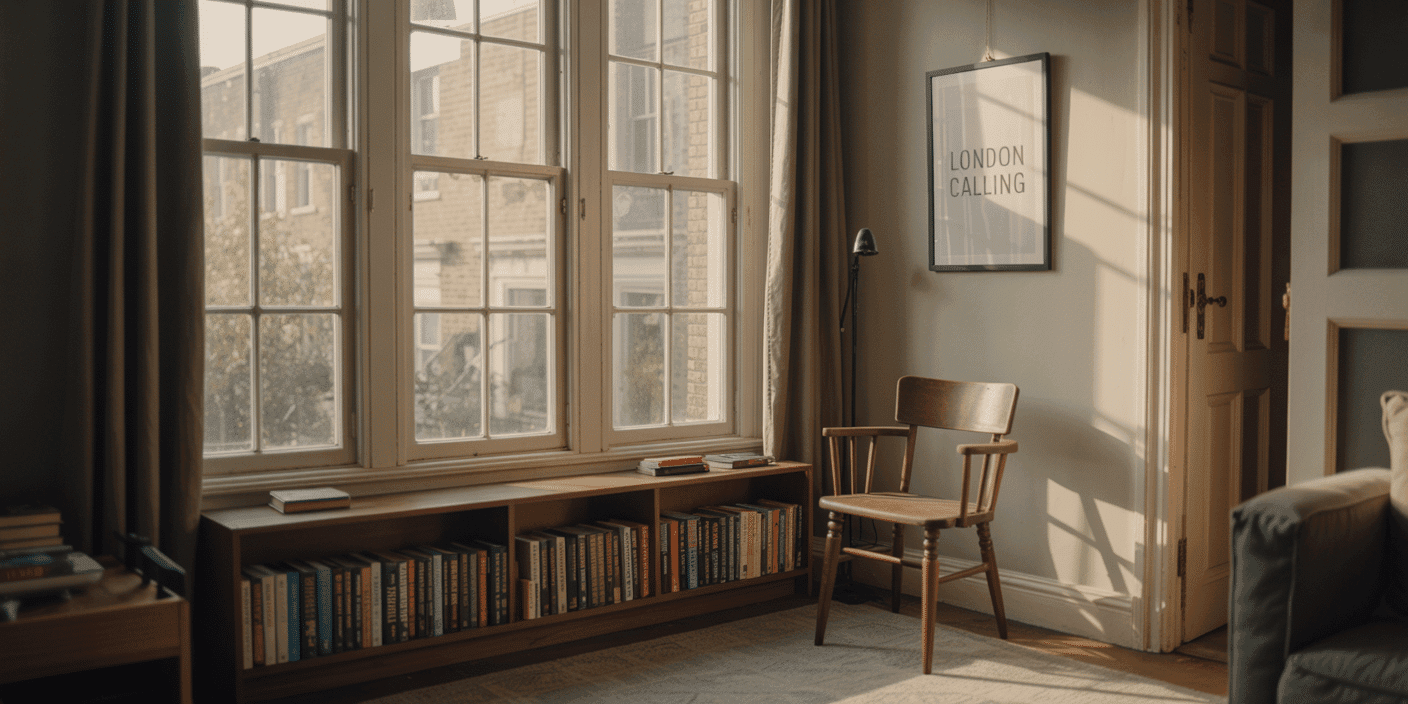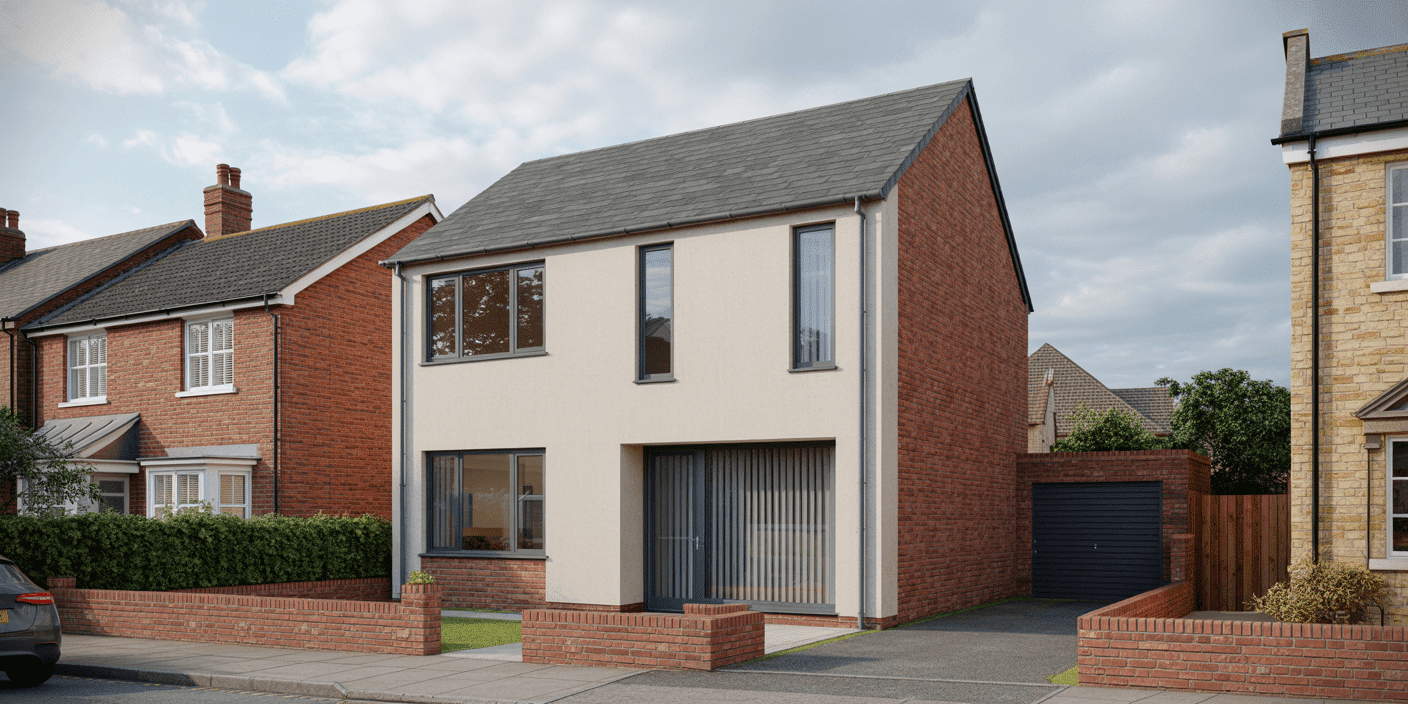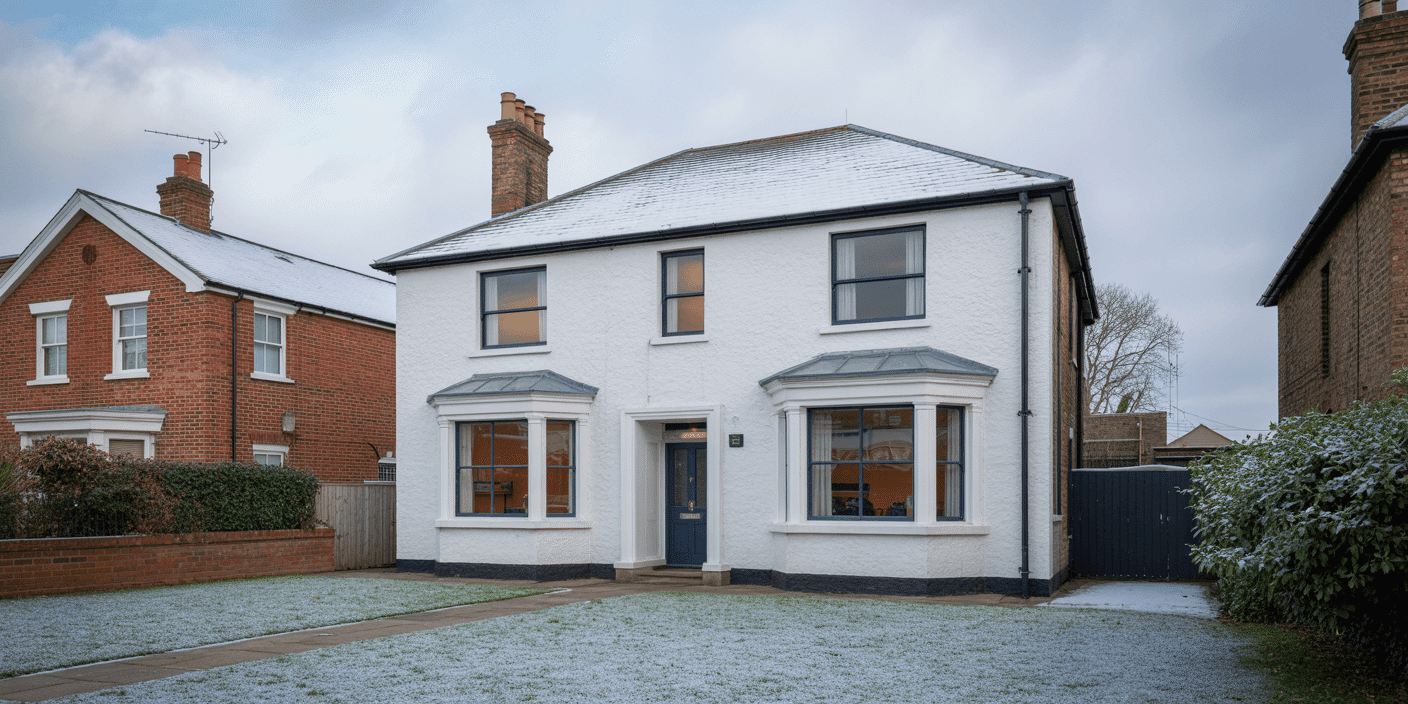The Silent Culprit Behind Rising Energy Bills
London’s most distinguished homes — with their soaring ceilings, intricate cornices, and elegant sash windows — were designed for grandeur, not thermal performance. Yet behind their architectural beauty lies a persistent and largely invisible inefficiency: the steady loss of heat through outdated glazing.
Each winter, the symptoms become all too familiar. Cold draughts seep through the panes. Boilers work overtime. Heating costs climb steadily — and comfort remains elusive. In period and listed properties, the issue is particularly acute. Here, heat loss isn’t merely functional — it undermines the integrity and liveability of the space.
For many, the instinctive solution is double glazing. It’s a widely held belief, yet often an oversimplification. Not all glazing systems are suitable for historic frames or conservation environments — and not all deliver equal performance.
In such contexts, the distinction between traditional argon-filled double glazing and modern vacuum glazing becomes critical.
Because the real problem isn’t the age of your home.
It’s what’s sealed between your panes.
Glazing Today — The Two Titans: Argon vs Vacuum
In the world of modern window solutions, two dominant systems stand on either side of a crucial decision: argon-filled double glazing and vacuum glazing. On the surface, both promise energy savings and better insulation — but what lies beneath that promise reveals a story of limits, and of quiet innovation.
Argon-filled glazing is the known quantity. It has served the double glazing market for decades, relying on a sealed cavity of inert gas between two panes of glass. That gas — usually argon — slows heat transfer, helping retain warmth inside the home. It works, within reason. It’s widely available, relatively affordable, and accepted across much of the building industry.
But it comes with caveats. To be effective, argon-filled units must be thick — often upwards of 24mm, requiring chunkier frames that simply don’t suit traditional sashes or listed properties. In fact, for many conservation homes, the visual compromise alone makes them unsuitable. And when it comes to truly high-end thermal performance, argon systems begin to show their age.
On the other hand, vacuum glazing approaches the problem from a more elegant angle. By removing the air entirely — creating a vacuum between two glass panes — it eliminates thermal transfer at the source. No gas, no convective loops, no need for thickness. The result is extraordinary thermal performance in an ultra-thin profile.
This means a vacuum-glazed unit can match or surpass triple-glazing levels of efficiency, in just 6–12mm of total thickness. And that makes it a game-changer for sash windows, where space is limited, proportions matter, and authenticity is non-negotiable.
This isn’t just a technical choice. It’s architectural diplomacy: a technology that bridges the old with the new, performance with preservation. And increasingly, it’s the system architects, conservation officers, and discerning homeowners trust when aesthetics matter as much as efficiency.
Where argon glazing asks you to compromise, vacuum glazing quietly eliminates the need.
Argon-Filled Units: Decent, But Demanding

For years, argon-filled double glazing has been the dependable go-to. It improved on single glazing by offering better insulation, reduced draughts, and lower heating bills. For newer builds or standard suburban properties, it’s a reasonable solution — a step up from the past, albeit not the leap many believe it to be.
The principle is simple: two panes of glass separated by a sealed cavity, filled with inert argon gas. The gas slows the transfer of heat and cold between inside and outside, making rooms more temperate and homes marginally more efficient.
But the devil, as ever, is in the detail.
To reach even moderate performance levels — typically U-values between 1.2 and 1.6 W/m²K — argon-filled units must be thicker, sometimes over 24mm. That added bulk demands chunkier window frames, which often don’t suit the refined proportions of sash windows.
In fact, fitting argon-filled units into traditional sashes frequently means altering or replacing the original joinery — a sacrilege for listed buildings and a visual compromise for any period home. What’s more, these units can struggle with long-term performance. Over time, the argon gas can slowly seep out, especially if the seals degrade — meaning their insulating effectiveness diminishes year by year.
Acoustically, argon-filled glass offers some improvement, but only marginal. In a busy London street or under a Heathrow flight path, the difference is often imperceptible.
And while these systems are widely available and cost-effective upfront, they often come with hidden costs — frame alterations, loss of heritage detailing, and compromised longevity.
In short, argon-filled glazing is a solid option for homes that don’t need to preserve their soul.
But for those where history lives in every frame, it’s a decent choice that demands too much.
Vacuum Glazing: The Performance You Don’t See
Vacuum glazing is where modern science meets architectural subtlety. Instead of filling the space between two panes with gas — as argon-filled units do — vacuum glazing removes the air altogether. What’s left is a sealed vacuum: a space so empty, heat has nowhere to go.
This simple yet powerful concept results in performance figures that are nothing short of extraordinary. With U-values reaching as low as 0.4 W/m²K, vacuum glazing can outperform triple glazing — without the bulk, the weight, or the aesthetic compromise.
What truly sets vacuum glazing apart, however, is its remarkable slimness. Measuring as little as 6mm to 12mm in total thickness, these units are perfectly suited to timber sash frames, even original ones. That means no deep rebates, no visible alterations, no loss of period character. From street level, you wouldn’t know it’s there. And yet, your home feels warmer, quieter, and more composed.
For listed properties, this is a revelation. Planning authorities demand minimal intervention. Homeowners want authenticity. Vacuum glazing delivers both — silently, elegantly, invisibly.
But it doesn’t stop with thermal performance. Acoustic insulation is significantly better than argon-filled units. The vacuum barrier stifles sound transmission in the same way it slows heat: efficiently and without fuss. The result is a rare kind of peace — the kind that lets you forget you live in central London.
There’s a reason conservation architects, luxury developers, and heritage homeowners are turning to vacuum glazing: it solves every problem without creating a new one. No aesthetic compromise. No planning nightmares. No thermal gaps.
And when installed by a team who understands the nuances of period joinery — like Sash Windows London — it doesn’t just perform beautifully.
It disappears.
Inside the Numbers: What the Data Really Tells You
When it comes to glazing, the language of performance can feel dense — U-values, decibels, thermal breaks. But behind these figures lie real consequences for comfort, cost, and compliance. This is where the true gulf between argon-filled and vacuum glazing is laid bare — not in theory, but in measurable, repeatable fact.
Let’s start with the U-value, the industry standard for measuring how well a window prevents heat transfer. The lower the number, the better the insulation:
| Glazing Type | Typical U-Value (W/m²K) |
| Single Glazing (Historic) | ~5.0 |
| Argon-Filled Double Glazing | 1.2 – 1.6 |
| Vacuum Glazing | 0.4 – 0.7 |
That’s not a marginal gain. That’s a radical leap in performance — in a unit less than half the thickness of an argon-filled system.
To put this in real terms:
A home retrofitted with vacuum glazing in Hampstead showed a 37% reduction in annual heating demand, compared to the original single-glazed sash units, and a 19% improvement over modern argon-filled double glazing.
Then there’s acoustic insulation — crucial for homes near roads, rail, or under the Heathrow flight path. Vacuum glazing routinely delivers 2x the sound attenuation of argon-filled units, thanks to its non-conductive vacuum barrier and fine-tuned laminate options.
And where argon systems require 24mm+ cavities, vacuum glazing achieves better performance at just 6–12mm. This means it can be retrofitted into existing sash frames with minimal joinery work — ideal for listed or conservation homes where visual impact is closely scrutinised.
It’s also worth noting the long-term stability: argon gas can leak over time, reducing efficiency. Vacuum-sealed units are engineered with microspacers and edge seals that preserve their performance for decades — verified in real-world installations across London.
These aren’t abstract improvements. They’re the difference between a cold room and a warm retreat, between a daily distraction and a silent sanctuary, between replacing heritage and protecting it.
Sash Windows London understands these numbers not just on paper — but on site. We don’t quote specs. We install outcomes.
What Luxury Homeowners Are Really Buying

No one replaces heritage windows simply to save a few pounds on their heating bill. For high-end homeowners, the purchase is never just glass — it’s a statement. An upgrade in insulation is really an upgrade in everything else: peace, privacy, control, and pride.
At this level, you’re not just buying efficiency — you’re investing in the invisible luxuries of a home that feels right every day of the year.
Comfort without compromise
Vacuum glazing doesn’t shout its presence. It disappears into the architecture, letting the original timber frames and sightlines remain intact. You feel the benefit, but you don’t see the intrusion — no bulky frames, no modern distortion, no architectural betrayals.
Silence as a status symbol
True luxury is the absence of nuisance. Whether you live opposite Hyde Park or above a Chelsea wine bar, noise control is part of your quality of life. Vacuum glazing blocks street-level sound before it enters your home — a benefit argon-filled glass rarely delivers.
Aesthetics that align with the past
Unlike standard double glazing, vacuum units preserve slimline proportions and original frame geometry. In listed buildings, this makes all the difference — and, more importantly, gains favour with planning officers who won’t tolerate modern mismatches.
Confidence in compliance
With U-values that exceed Part L, and thickness that satisfies Part K and Q, vacuum glazing future-proofs your property. It aligns tradition with regulation — meaning less red tape, faster approvals, and fewer compromises.
Pride of ownership
Ultimately, this is about integrity. A well-executed glazing upgrade tells a silent story about how much care you’ve taken — not just for comfort, but for the building itself. It’s a signal to guests, to buyers, and to yourself that no detail was overlooked.
At Sash Windows London, we see this every day. Homeowners aren’t looking for trends — they’re looking for timelessness, precision, and peace. Vacuum glazing delivers all three.
And when that quiet comfort is achieved without altering a single historic line of your façade?
That’s not just a purchase.
That’s prestige.
Why Craftsmanship Still Matters (And Always Will)
Glazing technology can only go so far. The real transformation begins — and ends — with the people who install it. A pane of vacuum glass, no matter how advanced, is only as effective as the joinery that surrounds it. In heritage homes, this truth is magnified: installation is not a trade — it’s a discipline.
At Sash Windows London, we’ve built our reputation on understanding this balance. Our work begins long before the glass arrives. We read the building — its timber quirks, its frame dimensions, its conservation restrictions — like a watchmaker reads a movement. Every millimetre matters. Every line must be honoured.
Where larger firms push for replacements, we refine and retrofit. Our craftspeople specialise in integrating vacuum glazing into existing sash frames — preserving the original architecture, elevating the performance, and satisfying the most meticulous planning departments in London.
It’s a slow art. But that’s the point.
Because true luxury isn’t delivered through catalogue solutions or bulk orders. It’s measured in margin-of-error precision. In knowing when to plane by hand instead of a machine. In sourcing the right putty mix for a 19th-century frame. In respecting the past while preparing the home for the future.
Many glazing companies install glass. Few install confidence. Fewer still install legacy.
When your home is a piece of architectural heritage — a listed building in Kensington, a Georgian terrace in Islington, a Victorian townhome in Dulwich — you need more than a product.
You need a partner who knows what can’t be bought: craftsmanship, patience, and taste.
That’s why architects recommend us. Why conservation officers trust us. And why our work remains long after the paperwork fades.
Technology evolves. But craftsmanship endures.
Your Home Deserves the Right Kind of Quiet
In the end, this isn’t about glass. It’s about how your home feels — in winter, in traffic, in silence. It’s about comfort that doesn’t compromise beauty, and warmth that doesn’t demand visible change. It’s about reclaiming control over your environment — not just in energy efficiency, but in calm, elegance, and permanence.
Vacuum glazing doesn’t draw attention to itself. It simply works.
Silently. Invisibly. Perfectly.
For homeowners who demand more — not just better figures, but finer finishes — the answer isn’t louder, thicker, or newer.
It’s smarter. Slimmer. Seamless.
At Sash Windows London, we specialise in pairing cutting-edge performance with heritage sensitivity. Whether you’re restoring a listed townhouse or refining a Georgian gem, we retrofit vacuum glazing with surgical precision — protecting your home’s soul while upgrading every single pane.
Ready to see the difference?
- Visit one of our in-situ projects across London’s finest postcodes
- Book a heritage glazing consultation with our craftspeople
- Download our vacuum glazing spec pack (U-values, planning tips, case studies)
- Browse our portfolio: Fitzrovia, Highgate, Chelsea, Dulwich
Because your home shouldn’t just look quiet.
It should feel quiet — all the way through.







